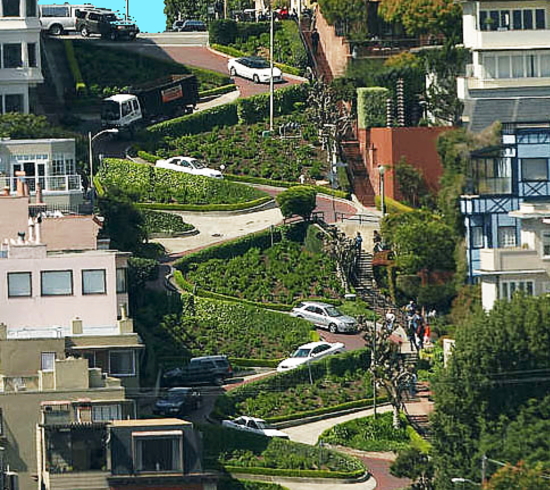
| San Francisco CA: Ya Gotta Experience Lombard Street |
 |
 Guest Senior Venturer YLH, Chicago IL: The one thought I always have when visiting that one crazy block of Lombard Street is: the people who live in these houses must be really tired of seeing hordes of climbing tourists. Worse, lines of creeping sightseeing cars jamming their street every hour of every day and night. Actually the city's Lombard Street is not confined to this one block, but the famous spot is a one-way meander between Hyde and Leavenworth Streets. It features eight very sharp zigzags, and boasts "the crookedest street in the world". Of course, any Washington DC street where politicians roam is certainly much more crooked in theory, if not actuality. The crooked quarter-mile block was developed about 90 years ago when a builder first erected houses on that craggy Lombard steep hillside. His idea was to stagger the street because it was on an almost 30 degree grade. At the time almost impossible for rickety, top-heavy 1920s cars to drive up, it became a one-way, bright-red brick and cobblestone-paved street, and driving downward became the only direction. Even today, it can be hazardous for cars to descend, and signs all over the street warn drivers to stay within the five-mile-an-hour limit or they could be ticketed or cause accidents. Of course, pedestrians can walk it either way, and it takes a hardy climber to make it from bottom to top. We were there about a year ago, standing at the little garden plot at the bottom, snapping and selfing away along with all the other tourists. Then, a troop of Boy Scouts arrived. After a pep talk from their leader, with flag unfurled, they began a quick ascent. We seniors decided to follow them, but made it only about half way. However, the boys carried their flag to the top and stood triumphant like the Marines on Iwo Jima. Just as a matter of curiosity, I checked prices of the homes when they were first offered in the 1920s. For the large, two-story structures, the price was between $11,000 and $15,000, a fairly high figure for that time, when the average American home cost $5,000. For-sale ads today list them from $2 million and up. |